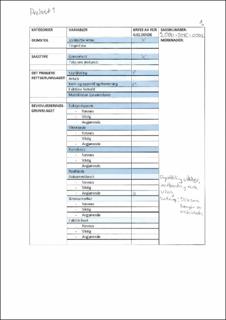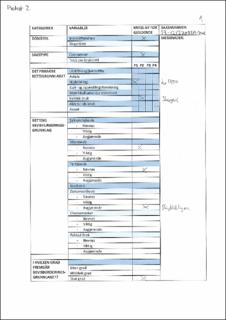| dc.contributor.author | Nygaard, Oskar Andreas | |
| dc.date.accessioned | 2021-08-11T12:02:48Z | |
| dc.date.available | 2021-08-11T12:02:48Z | |
| dc.date.issued | 2021 | |
| dc.identifier.uri | https://hdl.handle.net/11250/2767380 | |
| dc.description | Masteroppgave i areal og eiendom.
Fakultet for ingeniør- og naturvitskap/ Institutt for byggfag/ Høgskulen på Vestlandet, campus Bergen. | en_US |
| dc.description.abstract | I denne masteroppgaven har jeg hatt som mål å studere om det er forskjeller på bevisvurderingen i tingretten og jordskifteretten. Dette har vist seg å være et særdeles komplekst og sammensatt tema.
I den sammenheng har jeg utarbeidet et kodeskjema som er blitt brukt for å kartlegge og klassifisere hvilke bevis som inngår i rettens bevisvurdering fra dommene i datagrunnlaget. Totalt er 76 ulike dommer blitt kodet og analysert, og disse danner grunnlaget for funnene som blir presentert i oppgaven.
Hovedproblemstillingen for masteroppgaven er:
Er det forskjell på bevisvurderingen i tingretten og jordskifteretten?
Videre er hovedproblemstillingen delt inn i to underproblemstillinger for å konkretisere forskningsspørsmålet:
1) Hvordan vurderes bevis av samme type i lignende saker i henholdsvis tingretten og jordskifteretten?
- Er noen bevistyper mer fremtredende i jordskifteretten enn i tingretten eller vice versa?
2) I hvilken grad fremgår det av bevisvurderingen, i henholdsvis tingretten og jordskifteretten, hvordan de ulike bevisene er vektlagt?
Funnene indikerer at det er tendenser til forskjeller i rettens bevisvurdering i henholdsvis tingretten og jordskifteretten, men at problemstillingen er sammensatt. I underproblemstilling 1 viser dette seg ved at det på lang vei er flere observasjoner knyttet til variabelen «avgjørende» når det kommer til rettens bevisvurdering og vektlegging av dokumentbevis i jordskifteretten kontra tingretten.
I underproblemstilling 2 er det indikasjoner for at jordskifteretten forklarer seg bedre enn tingretten rundt bevisvurderingen, og der hvor en tingrettsdommer oftere vektlegger en helhetsvurdering, er det lettere å følge jordskiftedommerens drøftelser rundt enkelte bevis.
Samtidig er det elementer som gjør at forutsetningene ikke alltid like mellom de respektive domstolene. Forskjeller i erfarings- og utdanningsbakgrunn blant dommerne, ulike prosessordninger, jordskifterettens utvidede veiledningsplikt og jordskifterettens saklige kompetanse gjør at det er faktorer som styrer bevisvurderingen lenge før bevisene faktisk skal vurderes. | en_US |
| dc.description.abstract | In this master's thesis, I have investigated whether there are differences in the assessment of evidence in the district court and the land consolidation court. This has proven to be a complex and compound topic.
In this regard, I have prepared a code form wich has been used to map and classify the evidence included in the court's assessment of evidence from the jugdements seen in the data. A total of 76 different jugdements have been coded and analyzed, and these form the basis for the results presented in this thesis.
The main research question is set out below:
Is there a difference between the assessment of evidence in the district court and the land consolidation court?
Furthermore, the main research question is divided into two sub-questions for concretization:
1) How is evidence of the same type assessed in similar cases in the district court compared to the land consolidation court?
- Are any types of evidence more prominent in the land consolidation court than in the district court or vice versa?
2) To what extent does the assessment of evidence, in the district court and the land consolidation court, state how the various pieces of evidence are emphasized?
The results indicate that the court's assessment of evidence in the district court and the land consolidation court tends to differ, however, the issue is complex. In sub-question 1, this is shown by the fact that there are several observations related to the variable "decisive" when it comes to the court's assessment of evidence and emphasis on document evidence in the land consolidation court compared to the district court.
In sub-question 2 there are indications that the land consolidation court explains itself better than the district court with regards to the assessment of evidence, and where a district court judge more often emphasizes an overall assessment, it is easier to follow the land consolidation judge's discussions about certain evidence.
At the same time, there are elements that mean that the conditions are not always equal between the respective courts. Differences in experience and educational background among the judges, different processes, the land consolidation court's extended duty of supervision and the land consolidation court's factual competence mean that factors govern the evaluation of evidence long before the evidence is actually assessed. | en_US |
| dc.language.iso | nob | en_US |
| dc.publisher | Høgskulen på Vestlandet | en_US |
| dc.rights | Navngivelse 4.0 Internasjonal | * |
| dc.rights.uri | http://creativecommons.org/licenses/by/4.0/deed.no | * |
| dc.title | Er det forskjell på bevisvurderingen i tingretten og jordskifteretten? | en_US |
| dc.title.alternative | Is there a difference between the assessment of evidence in the district court and the land consolidation court? | en_US |
| dc.type | Master thesis | en_US |
| dc.description.localcode | MOA300 | en_US |




